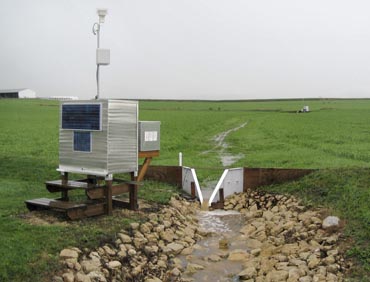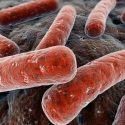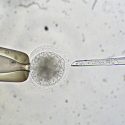Phosphorus management system balances farms, water quality
At any given spot in Wisconsin, chances are that you’re not far from a lake or a farm, or both – but the combination is not always a harmonious one. The future of both may hinge on proper management of an essential element: phosphorus.

Rain water runoff from an agricultural field is channeled through a flume at the Pioneer Research Farm in Platteville, Wis., on Aug. 17, 2005. Monitoring equipment connected to the flume records the volume, velocity and chemical make-up of such water runoff. Researchers at the University of Wisconsin–Madison are working on a Wisconsin Phosphorus Index (P Index) and software program to provide farmers with nutrient management tools and practices to help assess and reduce farm fertilizer runoff.
Photo: courtesy Randy Mentz/Pioneer Research Farm
"Having an adequate amount of phosphorus in the soil is extremely important – you can’t grow crops without it," says Laura Good, a UW–Madison soil scientist. However, excess phosphorus that reaches surface waters can pollute lakes and streams and destroy aquatic ecosystems.
The Wisconsin Phosphorus Index (P Index) may help strike a balance between agricultural needs and water quality in the state. This assessment and planning tool, developed by UW–Madison in partnership with several governmental agencies, is designed to help farmers and agricultural consultants plan manure applications by calculating field phosphorus runoff potential. Such information may also help guide management practices to meet water quality improvement goals.
Good, who is coordinator of the Wisconsin P Index project, says many fields have been over-fertilized with phosphorus in the past. Use of manure, which contains a higher percentage of many crops’ phosphorus needs than nitrogen needs, can lead to excess soil phosphorus if fields are fertilized with amounts sufficient to meet crops’ nitrogen requirements.
As a general rule, she says, as phosphorus levels in the soil rise, so does the amount of phosphorus in runoff that comes into contact with that soil. Since phosphorus is the "limiting nutrient" in most freshwater ecosystems, adding additional phosphorus increases the likelihood of algae blooms that can kill aquatic plants and animals.
"When you add phosphorus, you increase algal growth," says Good. As those algae die and decompose, "You can get green, stinky water."
In recognition of the potential environmental impacts of phosphorus use, the federal government currently requires each state to develop methods, such as a phosphorus index, to manage manure applications to reduce the risk of surface water contamination with phosphorus.
The Wisconsin P Index is a set of algorithms, developed in-house at the UW–Madison Department of Soil Science, that estimates for individual farm fields the potential for phosphorus runoff from the field to nearby surface water. Unlike some other manure phosphorus management programs, which focus only on soil phosphorus levels, the P Index considers many factors – including crop history, manure and fertilizer application, tillage practices, erosion rates, and runoff volumes – to assess the actual risk of phosphorus reaching surface water under those conditions.
The development of this P Index has been grounded in science, aided by a close working relationship between UW–Madison and the governmental agencies responsible for agricultural nutrient management planning policy in Wisconsin, including the U.S. Department of Agriculture Natural Resources Conservation Service, the Wisconsin Department of Agriculture, Trade, and Consumer Protection, and the Wisconsin Department of Natural Resources, Good says. Many P Index equations, including those that use readily accessible field parameters to estimate phosphorus levels in field runoff, were developed using data from small plot and laboratory research at the department of soil science.
The UW–Madison researchers are also working with producing farms across the state, including the experimental Pioneer Farm at UW-Platteville and members of the UW-Extension Discovery Farms program, to evaluate how well the P Index models reflect what is really happening on active fields.
"We calibrate it against actual losses in the field," comparing P Index estimates with long-term monitoring data from multiple sites on the farm, says Chris Baxter, a nutrient management specialist at Pioneer Farm and agronomist at UW-Platteville. "We’re taking science from the small scale up to a broader scale."
Similar field-scale testing on the Discovery Farms is providing information "directly related to what producers should see in their fields if they were using the P Index," says Dennis Frame, co-director of the Discovery Farms program. Located across the state, the Discovery Farms are privately owned commercial farms that work with UW scientists to evaluate various farm management practices.
Collecting data from Wisconsin farms ensures that the models correspond to the soil types and farming practices used in the state, says Good.
In addition to helping calibrate the models, Frame says this real-world testing is also essential to creating a tool that agricultural producers can use. "This has to be something that fits their belief system and how they want to farm," he says.
"Our goal is to make this tool not just an environmental index, but a way to be useful to the farmer too," Good says.
In addition to providing a way for farmers to meet statewide nutrient management standards, the Snap-Plus software package, which includes the P Index calculator, also includes extra record-keeping and planning features that growers may find useful, she explains. For example, the program recommends target levels of phosphorus and nitrogen for individual fields, which can help farmers plan fertilizer applications, identify potential problem sites on their land, and even simulate changes to predict how specific actions will affect phosphorus levels.
"Farmers can make changes and see how those changes impact phosphorus loss without actually taking the risk out on the field," says Baxter.
In addition, Good says, landowners can weigh different options and find ways to comply with governmental and environmental guidelines that are best suited to their specific circumstances. "The conservation lessons that can come from nutrient planning are much more likely to come through if the software is useable and useful," she says.
The bottom line, Good says, is to create something that will benefit both farmers and natural resources. "We need a planning tool that will, without frustration, give accurate assessments for farmers’ real management alternatives."
Subscribe to Wisconsin Ideas
Want more stories of the Wisconsin Idea in action? Sign-up for our monthly e-newsletter highlighting how Badgers are taking their education and research beyond the boundaries of the classroom to improve lives.



